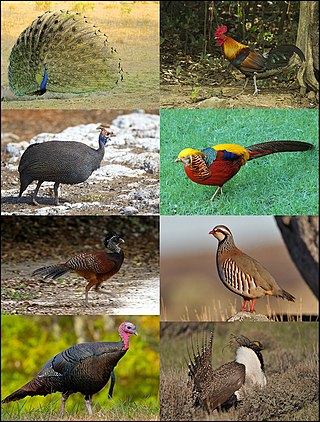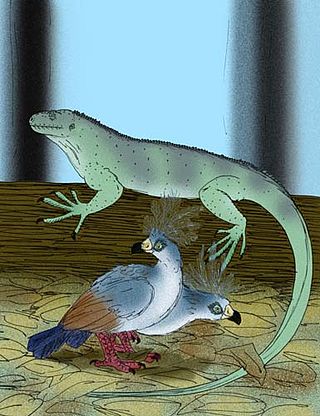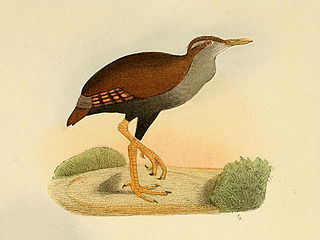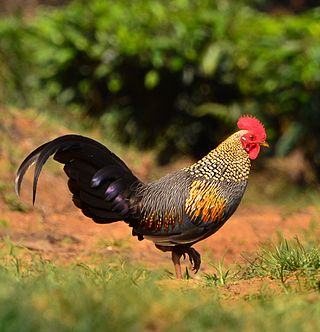
Moa are an extinct group of flightless birds formerly endemic to New Zealand. During the Late Pleistocene-Holocene, there were nine species. The two largest species, Dinornis robustus and Dinornis novaezelandiae, reached about 3.6 metres (12 ft) in height with neck outstretched, and weighed about 230 kilograms (510 lb) while the smallest, the bush moa, was around the size of a turkey. Estimates of the moa population when Polynesians settled New Zealand circa 1300 vary between 58,000 and approximately 2.5 million.

Galliformes is an order of heavy-bodied ground-feeding birds that includes turkeys, chickens, quail, and other landfowl. Gallinaceous birds, as they are called, are important in their ecosystems as seed dispersers and predators, and are often reared by humans for their meat and eggs, or hunted as game birds.

The megapodes, also known as incubator birds or mound-builders, are stocky, medium-large, chicken-like birds with small heads and large feet in the family Megapodiidae. Their name literally means "large foot" and is a reference to the heavy legs and feet typical of these terrestrial birds. All are browsers, and all except the malleefowl occupy wooded habitats. Most are brown or black in color. Megapodes are superprecocial, hatching from their eggs in the most mature condition of any bird. They hatch with open eyes, bodily coordination and strength, full wing feathers, and downy body feathers, and are able to run, pursue prey, and in some species, fly on the same day they hatch.

Flightless birds are birds that, through evolution, lost the ability to fly. There are over 60 extant species, including the well-known ratites and penguins. The smallest flightless bird is the Inaccessible Island rail. The largest flightless bird, which is also the largest living bird in general, is the ostrich.

Dromornithidae, known as mihirungs and informally as thunder birds or demon ducks, were a clade of large, flightless Australian birds of the Oligocene through Pleistocene Epochs. All are now extinct. They were long classified in Struthioniformes, but are now usually classified as galloanseres. Dromornithids were part of the Australian megafauna. One species, Dromornis stirtoni, was 3 m tall. Only a single species, Genyornis newtoni survived into the Late Pleistocene. They are thought to have been herbivorous.

Sylviornis is an extinct genus of large, flightless bird that was endemic to the islands of New Caledonia in the Western Pacific. It is considered to constitute one of two genera in the extinct family Sylviornithidae, alongside Megavitiornis from Fiji, which are related to the Galliformes, the group containing the turkeys, chickens, quails and pheasants. Sylviornis was never encountered alive by scientists, but it is known from many thousands of subfossil bones found in deposits, some of them from the Holocene, on New Caledonia and the adjacent Île des Pins. It was likely hunted to extinction shortly after the first human arrival to New Caledonia around 1500 BC.

Sylviornithidae is an extinct family of flightless birds, known from subfossil bones found in Holocene aged deposits on the Melanesian islands of New Caledonia and Fiji. Traditionally assumed to be within Galliformes, recent phylogenetic studies showcase that they rest outside of the galliform crown-group, making them the most recently lived non-galliform Pangalliformes. For many years it was considered a monotypic family consisting of Sylviornis alone, but recent studies show that Megavitiornis was part of this clade as well.

The Viti Levu giant pigeon or Fiji giant ground pigeon is an extinct flightless pigeon of Viti Levu, the largest island in Fiji. It was only slightly smaller than the dodo and Rodrigues solitaire and is the first giant flightless pigeon to be discovered on a Pacific island.
The long-billed wren is an extinct species of New Zealand wren formerly endemic to the South Island of New Zealand. It was the only species in the genus Dendroscansor. It shares the name "long-billed wren" with the Brazilian bird Cantorchilus longirostris.

The bar-winged rail is an extinct species of bird in the family Rallidae. It was endemic to Fiji and was last collected ca 1890 in Viti Levu. The species was identified from twelve 19th century specimens, some of which are known to be in Boston, London and New York. The last unconfirmed sighting of this bird was in 1973.
Trevor Henry Worthy is an Australia-based paleozoologist from New Zealand, known for his research on moa and other extinct vertebrates.

Volia is an extinct monospecific genus of mekosuchine crocodylian closely related to Mekosuchus and Trilophosuchus. Volia is known from a collection of largely fragmentary remains including skull bones and limbs recovered from the Voli Voli and Wainibuku Caves on Viti Levu (Fiji), with similar remains having been found on Naigani. It was around 2–3 metres (7–10 ft) long, making it the largest predatory animal on the island and subsequently most likely the apex predator of the Pleistocene ecosystems of Fiji. It may have fed on giant iguanas, flightless birds or even fish. Like its closest relatives, it may have been more terrestrial than today's crocodiles.

The snipe-rail is an extinct flightless rail endemic to the North Island of New Zealand. The species' name is derived from the Karamu Cave 21 kilometres (13 mi) from Hamilton where the holotype was discovered in 1954.
Vitirallus watlingi, the Fiji rail or Viti Levu rail, was a prehistoric flightless bird from Fiji, and is the only species in the genus Vitirallus. Vitirallus watlingi is thought to have been about the same size as the bar-winged rail but with a very elongated and slender bill.

Pangalliformes is the scientific name of a provisional clade of birds within the group Galloanserae. It is defined as all birds more closely related to chickens than to ducks, and includes all modern chickens, turkeys, pheasants, and megapodes, as well as extinct species that do not fall within the crown group Galliformes.
The Viti Levu scrubfowl, also known as the Fiji scrubfowl or lost megapode, is an extinct megapode that was endemic to Fiji. The epithet amissus, from Latin "lost", refers to its extinction. Subfossil remains were collected from the Udit cave at Wainibuku on the island of Viti Levu in October 1998 by Trevor Worthy, G. Udy and S. Mataraba, and described by Worthy in 2000. The holotype is held by the Museum of New Zealand.

Progura is an extinct genus of megapode that was native to Australia. It was described from Plio-Pleistocene deposits at the Darling Downs and Chinchilla in southeastern Queensland by Charles De Vis.
The Pindai Caves of New Caledonia are an archaeological and palaeontological site important for the study of prehistoric human settlement as well as of the Holocene fauna of the island. The Pindai area has been occupied by humans for varying periods over the last 2,800 years.
Mwalau walterlinii is an extinct species of megapode from Vanuatu, and the only species in the genus Mwalau. The holotype and only known specimen is from the Teouma archeological site on the island of Efate. It was built in similar proportion to the extant Australian brushturkey, and, like that species, could fly. It is distinguishable from other extant megapodes by its large size, though it is smaller than the extinct giant malleefowl.














